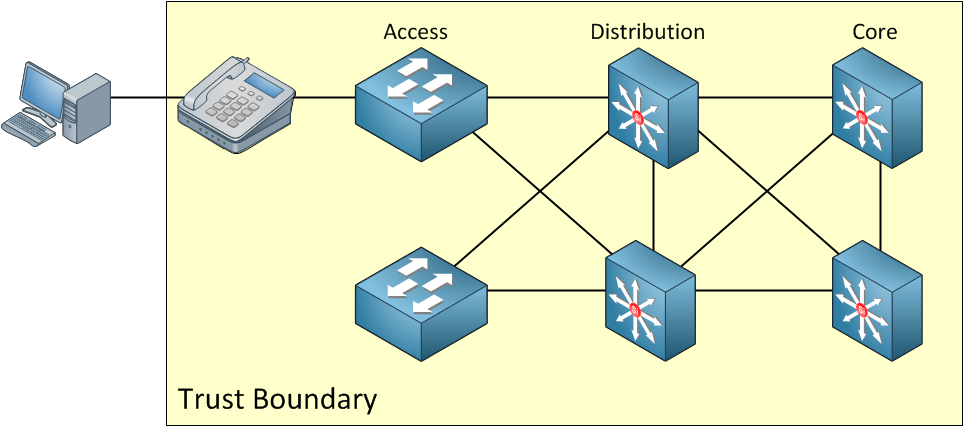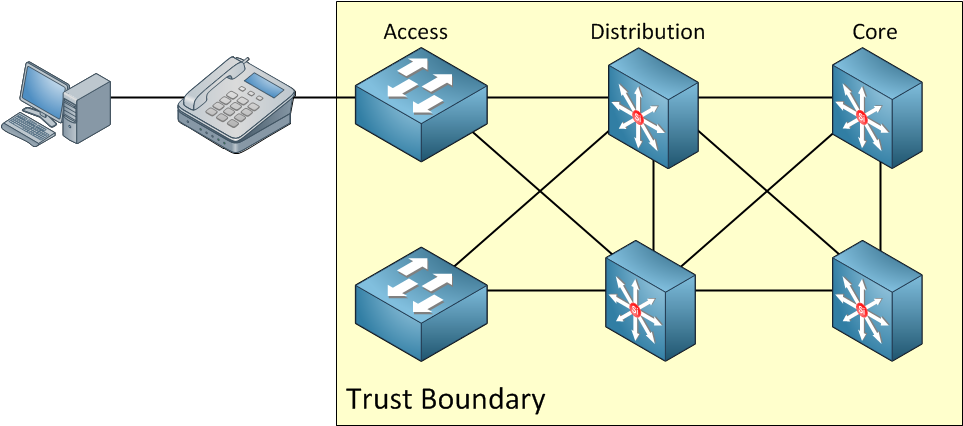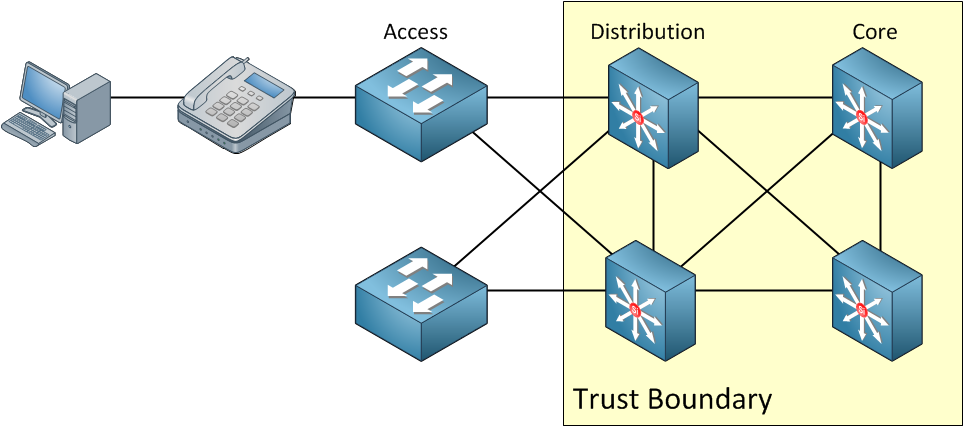When configuring QoS on our Cisco switches we need to think about our trust boundary. Simply said this basically means on which device are we going to trust the marking of the packets and Ethernet frames entering our network. If you are using IP phones, you can use those for marking and configure the switch to trust the traffic from the IP phone. If you don’t have any IP phones or don’t trust them, we can also configure the switch to do the marking. In this lesson, I’ll show you how to do both! First, let me show you the different QoS trust boundaries:

In the picture above the trust boundary is at the Cisco IP phone, this means that we won’t remark any packets or Ethernet frames anymore at the access layer switch. The IP phone will mark all traffic. Note that the computer is outside of the QoS trust boundary. This means that we don’t trust the marking of the computer. We can remark all its traffic on the IP phone if we want. Let’s take a look at another picture:

In the picture above, we don’t trust whatever marking the IP phone sends to the access layer switch. This means we’ll do classification and marking on the access layer switches. I have one more example for you…

Above you can see that we don’t trust anything before the distribution layer switches. This is something you won’t see very often, but it’s possible if you don’t trust your access layer switches. Maybe someone else does the management for the access layer switches and you want to prevent them to send packets or Ethernet frames that are marked towards your distribution layer switches.
Let’s take a look at a switch to see how we can configure this trust boundary. I have a Cisco Catalyst 3560 that I will use for these examples. Before you do anything with QoS, don’t forget to enable it globally on your switch first:
3560Switch(config)#mls qos
Something you need to be aware of is that as soon as you enable QoS on your switch, it will erase the marking of all packets that are received! If you don’t want this to happen, you can use the following command:
3560Switch(config)#no mls qos rewrite ip dscp
Let’s continue by looking at the first command. We can take a look at the QoS settings for the interface with the show mls qos interface command. This will show you if you trust the marking of your packets or frames:
3560Switch#show mls qos interface fastEthernet 0/1 FastEthernet0/1 trust state: not trusted trust mode: not trusted COS override: dis default COS: 0 DSCP Mutation Map: Default DSCP Mutation Map Trust device: none
Above you can see that we don’t trust anything at the moment. This is the default on Cisco switches. We can trust packets based on the DSCP value, frames on the CoS value, or we can trust the IP phone. Here are some examples:
3560Switch(config-if)#mls qos trust cos
Just type mls qos trust cos to ensure the interface trusts the CoS value of all frames entering this interface. Let’s verify our configuration:
3560Switch#show mls qos interface fastEthernet 0/1 FastEthernet0/1 trust state: trust cos trust mode: trust cos COS override: dis default COS: 0 DSCP Mutation Map: Default DSCP Mutation Map Trust device: none
By default, your switch will overwrite the DSCP value of the packet inside your frame according to the cos-to-dscp map. If you don’t want this, you can use the following command:
3560Switch(config-if)#mls qos trust cos pass-through
The keyword pass-through will ensure that your switch won’t overwrite the DSCP value. Besides the CoS value, we can also trust the DSCP value:



Hi,
Nice explanation
We have a setup that a video device is connected to a switch (no qos) and marking done in the router AF41.
Here , the packet will be marking as Default when it goes from switch to router . Router will mark the packet as AF41. When there is a reply packet from the Router it will be AF41 and it send it to Switch as well.
Switch sends a packet to router : Default
Router sends a reply packet to switch : AF41
With same setup ,When we Qos enabled globally in the switch
Packet from switch to router :Default
... Continue reading in our forumReply packet from Router to Switch :Def
Hi Vin,
It depends on your network, if you don’t do any queuing on the switch then it’s fine to mark on the router. If you implement on the queuing on the switch(es) then I would also mark there.
Keep in mind that enabling QoS globally on the switches will impact your marking. Catalyst IOS switches will remark traffic according to the Cos-to-DSCP or DSCP-to-Cos map.
Rene
Thank you very much for the lesson!
BTW, is it possible to remark priority of only frames that belong to a particular VLANs while keep others without remarking?
You are welcome and yes you can do that.
Very nice lesson!
Do you have any recommendations on using an Askerisk based phone system with current Cisco 3560’s. All the SWs are all set with QoS for the current Cisco phone system. Will the markings be the same?